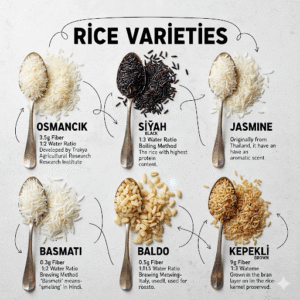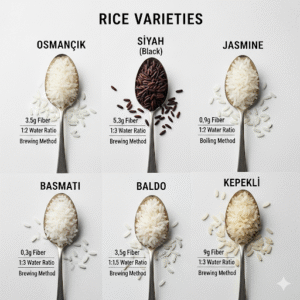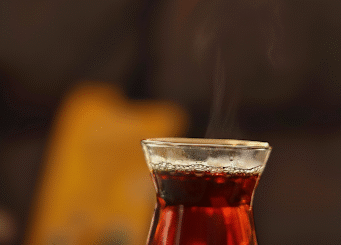A Guide to Rice Varieties: Which Rice is Right for Your Dish?

A Guide to Rice Varieties: Which Rice is Right for Your Dish?
Rice is an indispensable part of world cuisines. There are countless rice varieties, each with a different texture, aroma, and use. So, what are the most popular types of rice, and how can we use them in the kitchen? Here is your guide to rice varieties that will not only help you create delicious meals but also add health benefits!

1. Osmancık Rice: A Staple of Turkish Cuisine
Fiber Content: 3.5g
Water Ratio: 1:2 (1 measure of rice to 2 measures of water)
Cooking Method: Brewing (absorption)
Characteristics: Developed by the Trakya Agricultural Research Institute, Osmancık rice is one of the most preferred rice types in Turkish cuisine. Its medium-grain structure makes it ideal for pilafs, stuffed vegetables, and wraps. It cooks up fluffy and separate.
2. Black Rice: The Rising Star of the Superfood Trend
Fiber Content: 5.3g
Water Ratio: 1:3 (1 measure of rice to 3 measures of water)
Cooking Method: Boiling
Characteristics: Also known as “forbidden rice,” black rice is notable for its high antioxidant content and nutritional value. It is one of the rice varieties with the highest protein content. When cooked, it turns a purplish-black color and has a slightly nutty taste. It is a great option for salads, side dishes, or exotic pilaf recipes.
3. Jasmine Rice: Aromatic Touches
Fiber Content: 0.9g
Water Ratio: 1:2 (1 measure of rice to 2 measures of water)
Cooking Method: Brewing (absorption)
Characteristics: Originally from Thailand, jasmine rice is known for its distinct floral and aromatic scent. It has a long-grain and slightly sticky texture. It is a perfect accompaniment for Asian cuisine, curries, and stir-fry dishes.
4. Basmati Rice: Fragrant and Fine-Grained Elegance
Fiber Content: 0.3g
Water Ratio: 1:3 (1 measure of rice to 3 measures of water)
Cooking Method: Brewing (absorption)
Characteristics: “Basmati” means ‘pleasant-smelling’ in Hindi. This rice is characterized by its long, thin grains. When cooked, the grains separate and offer a light, nutty aroma. It’s a staple in Indian and Pakistani cuisine, and ideal for biryani and various pilaf recipes.
5. Baldo Rice: The Italian Heart of Risotto
Fiber Content: 0.5g
Water Ratio: 1:1.5 (1 measure of rice to 1.5 measures of water)
Cooking Method: Brewing (typically by slowly adding water)
Characteristics: Originating from Italy’s risotto tradition, Baldo rice is a medium-grain rice with a high starch content. When cooked, it takes on a creamy consistency while the grains remain slightly firm inside. In addition to risotto, it can be used for desserts like rice pudding and other pilafs.
6. Brown Rice: The Healthy and Nutritious Option
Fiber Content: 9g
Water Ratio: 1:3 (1 measure of rice to 3 measures of water)
Cooking Method: Boiling
Characteristics: Brown rice is more nutritious because the bran and germ layers of the rice grain are left intact. Its high fiber content supports the digestive system and helps you feel full for longer. It takes a little longer to cook than white rice and has a chewier texture. It is a great choice for salads, vegetable dishes, and healthy pilaf recipes.
Which rice variety do you prefer? Share your favorite recipes with us in the comments!


